1973 Peugeot 504 Berline GL
Stephen Bayley explores the ineffable Frenchness of the Peugeot 504.
Photography Paul Harmer
GALLIC AS GARLIC — PEUGEOT 504 DECONSTRUCTED
Feasting on a car that was artisan bred
‘A CAR MANUFACTURED BY THE MAKERS OF THE BEST PEPPERMILLS AND DESIGNED BY THE MAN WHO DREW THE MOST BEAUTIFUL FERRARI’
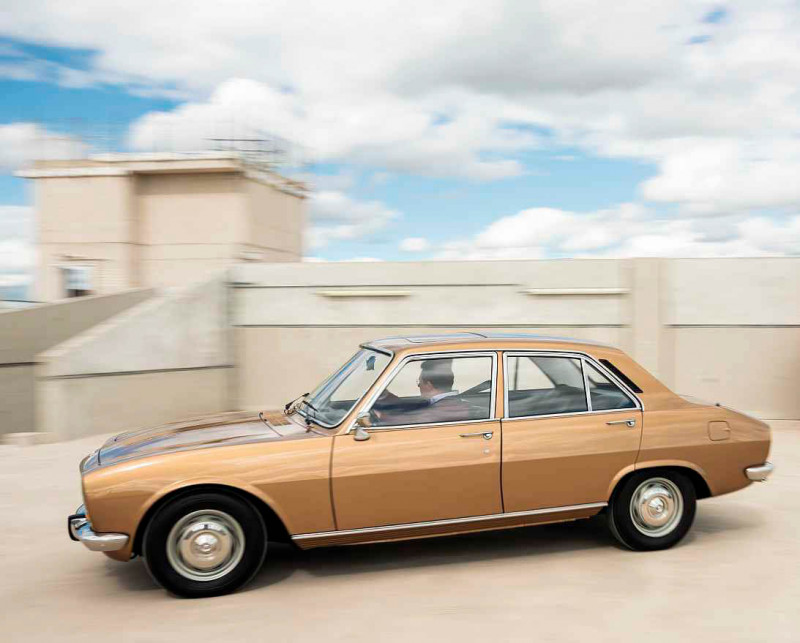
‘Structuralism’ is a mode of thought much favoured by French academics. Irreverently, it may be said to be a more intellectual approach to what we more matter-of-fact rosbifs call ‘inter-disciplinary’. But it’s a little more than that. The Structuralist point-de-vue is based on the assumption that everything has layers of meaning. That objects must be understood in a complete context. That there are not simplistic monocausal explanations of things. A belief that we are all mediators and translators of the world we occupy and see.
‘A tiny raised section at the back modestly reflects the Dino’s flying buttresses’
Sometimes this leads to dizzying bafflement, of being difficult for the sake of being difficult. For example: ‘We must observe the sliding of the signified beneath the signifier in the behavioural programme of the post-social society during the capitalist inter-regnum.’ I have just made that up, but you see what I mean. Yet sometimes it all leads to clarity. Let’s see how we get on here.

The 1968 launch of the Peugeot 504 was delayed until the Salon de l’Automobile in the autumn of that year because of les événements of that spring. These events were the radical uprising that began at Paris’s Nanterre University, when academics and students suspended their studies of bafflement and took to the streets.

There were barricades, riots, occupations of schools and factories. Young women in cashmere V-necks and pleated skirts lit up a Gitane and cheerfully chucked cobblestones at gendarmes. Eventually, a quarter of the population was in a frenzy and it got so bad that President de Gaulle briefly escaped to a French military base in Germany.
Then it all settled down as mysteriously as it had arisen. Les soixante-huitards, the ‘sixty-eighters’, resumed their studies. Workmen in bleu de travail put the roads back together. But it was le moment décisive: a turning point. Nothing would be quite the same again. Students were empowered, the mighty apparatus of La République had been made to wobble precipitously. Within a few years, hatchbacks would appear. Within ten years, Paris saw the building of the Centre Pompidou and expectations of architecture were changed forever.

And so we have the Peugeot 504, a car very much of its moment yet which also looks backwards. It was the successor to the 404, which was manufactured between 1960 and 1975, itself a very self-conscious successor to the 403, which dated back to 1955.
The 404 benefited from Pininfarina’s open-source design, in which the noble carrozzeria cheekily sold the same drawings to BMC where they were interpreted as the Morris Oxford and the Austin Cambridge. Arguably, the French got the better of the bargain. Both the 403 and the 404 were popular as column-shift taxis in Paris and, being simply specified while robustly made, assisted the French colonial project in Africa during its long autumn.
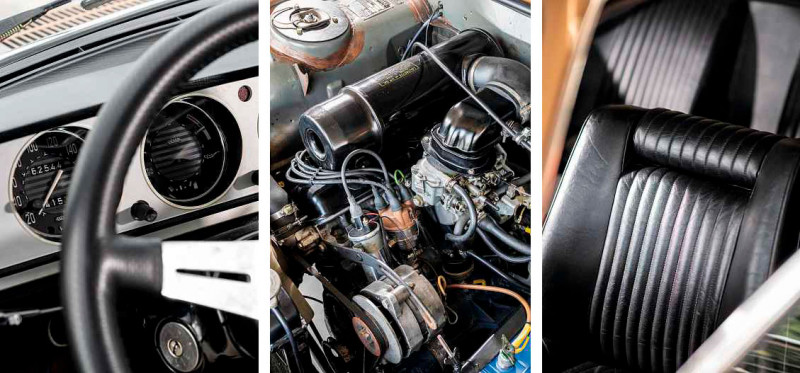
The 504, which lived until 1983 in Europe and 2006 in Nigeria, was more ambitious than the 404, although still technically straightforward. The torque-tube propeller shaft gave a solid link between engine and final drive that smoothed turning moments, greatly enhancing both comfort and durability for customers on the Boulevard Saint-Germain and in Ouagadougou.
It also boasted deliciously comfortable long-travel suspension and complementary seats of positively decadent squidginess. The ‘Break’ estate version ran on a wheelbase 6.3in longer and had a raised rear roofline, while the ‘Familiale’ had seven seats. Wagons and pickups had live axles, saloons and coupés semi-trailing arms.
The existing Pininfarina connection was reinforced when the production of the very pretty 504 coupés and cabrios was sent to Grugliasco, just outside Turin. Perhaps no enterprise of comparable size has ever been responsible for so much industrial beauty. It was not, of course, Pinin Farina who did all the drawing, any more than it was Enzo Ferrari who engineered all those cars. Instead, Farina of 1967 was assisted by elfin helpmeets who were not given much personal publicity. Neither did they ask for any.

Outstanding was Aldo Brovarone, born in Piedmont in 1926. Having moved to South America to work as a graphic designer in Buenos Aires, he came into contact with the mercurial and recently immigrated Piero Dusio who founded Autoar, or Automoviles Argentinos.
Dusio’s beautiful Pininfarina-designed Cisitalia from his pre-Argentina era, the original ‘GT’, later became the first car to be acquired for the permanent collection at New York’s Museum of Modern Art, scriptural home of the newly emergent ‘design’.
By 1952, Brovarone was back in Italy. Two years later he joined Pininfarina as an assistant to Francesco Salomone and Franco Martinego. At first his work was restricted to colouring-in the sketches of others, but soon he graduated to the autograph design of Roberto Rossellini’s Ferrari, the Alfa Romeo Superflow and a oneoff, fuoriserie, Ferrari 375 America for Gianni Agnelli.
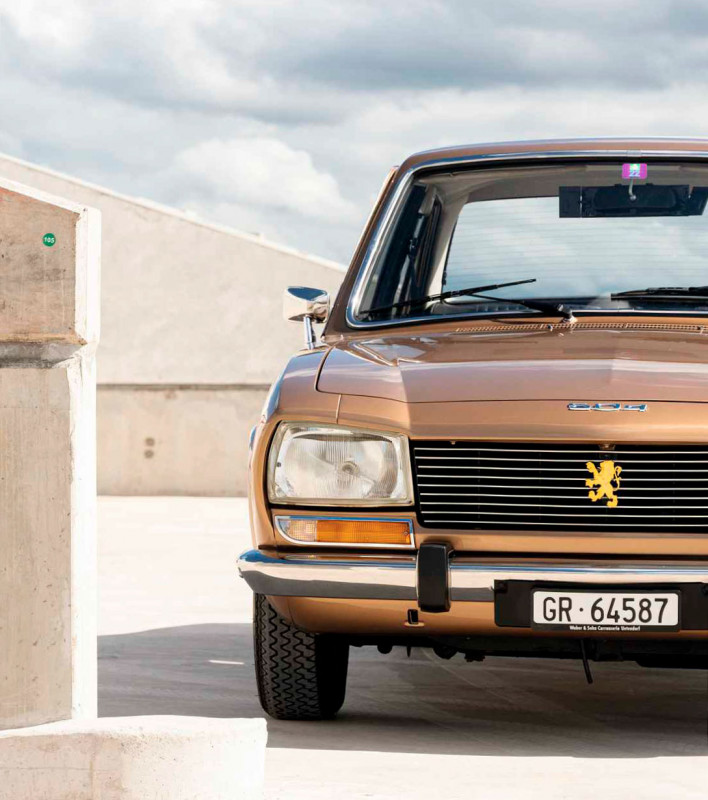
And it was for Ferrari that he did his most exceptional work. A 1965 show car called the Dino Berlinetta Speciale essayed the Dino 206 and 246 of 1967, to many the most beautiful cars ever. This was a completely original shape. The front wheelarches are emphatic, as they were on the contemporary Ferrari 330 P3 sports-racer, in my view the most beautiful racing car of them all. At the rear, a vertical glass is bent on a heroic concave radius, framed by lateral fins that taper to the tail.
And this feature you see on Brovarone’s 504: a tiny raised section at the back modestly reflects the Dino’s flying buttresses. And there are character lines a-plenty. There is the ghost of a Coke-bottle curve, less emphatic than the contemporary Vauxhall FD Victor’s or, two years later, the Ford Cortina MkIII’s, but nonetheless apparent. The 504’s trapezoidal headlights established a facial character that just about remains recognisable in the Peugeot physiognomy of today.
But before CAD, even Pininfarina’s sculpturally adroit designers had difficulty in realising voluptuous three-dimensional forms. The 504 meets the eye as a shape conceived in two dimensions – front elevation and side elevation – and only later on the production line amalgamated into a three-dimensional mass. Peugeot had no Scaglietti to render Pininfarina’s flat drawings into voluptuous shapes.
We find this 504 Berline, belonging to a Swiss collector, at Lance McCormack’s Romance of Rust in Brentford. This is a workshop in the heart of Duke of London, a collective of boutique car dealer, pizzeria, cinema and wine bar. McCormack is a master metal-basher, trained as a boy at the coachbuilder Mulliner, who has fastidiously re-bashed this Peugeot. But even his great artifice was not able to disguise that, in most cars of this era, doors, bonnets and boots open with the creaky imprecision of a vintage tin toy.
It was, structurally speaking, irresistible to shoot the pictures in a concrete parking garage, an architectural form reaching its maturity when the 504 was launched. Happily, there was one adjacent to Romance of Rust: serendipity. Parking garages speak a simple, uncomplicated language. There is only one purpose: to be a hotel for cars.
In Nikolaus Pevsner’s History of Building Types of 1976, car parks do not feature. To this great architectural historian, they had not achieved artistic distinction. Indeed, the very first car park, Auguste Perret’s Garage de la Société-Ponthieu-Automobiles of 1905, looks like something else entirely. But parking was soon to engage modernists’ imaginations. The Soviet architect Konstantin Melnikov had a bold concept in 1925 for a garage over the Seine. Nine years later in Venice, Eugenio Miozzi’s Autorimessa demonstrated the Futurist vision.
By the 1950s, parking garages were emerging as a distinct building type. There’s the amazing Parking Facility No.5 of 1952 by Chicago’s Loebl, Schlossman and Bennett. And when in 1959 Frank Lloyd Wright completed New York’s Guggenheim Museum with its amazing helical ramp, quite a few visitors recalled that the architect had tested this design on Max Hoffman’s car showroom at Park and 56th, cruelly demolished in 2013.
The genre reached its apogee in Gateshead with Owen Luder’s Trinity Square of 1967, immortalised in Michael Caine’s Get Carter the year before the Peugeot 504’s arrival. Brutalism was the favoured language of car park designers. No-one is saying that the fine 504 is in any way brutal, but it has a character determined by a culture that architects understand.
The 504, especially in its Break or Familiale versions, became a favourite of architects. In 1968, this tribe was identifiable by its corduroy suits, suede desert boots, statement glasses and polo-neck sweaters. The more prosperous of them might have owned an Eames chair, or had barometers and a ship’s clock attached to tongue-and-groove panelling and illuminated by spotlights.
English intelligentsia liked French cars. Indeed, French stuff in general. By 1968, Terence Conran’s Habitat stores were well established; here you would find Duralex glasses and other fine examples of vernacular chic.
Conran’s B-roll, soft-focus Francophilia involved long journeys after lunch along a plane-tree-lined Route Nationale in a gloriously floaty and hypnotising Citroën DS. And it found many takers among the discoverers of wine bars, quiche lorraine and profiteroles, a chicken brick and a butcher’s block.
But Peugeot’s Frenchness was more to do with workmanlike bleu de travail and rationality than with grande luxe or the gastronomy that will forever be associated with the Citroën DS. Or, if not the roadmender’s or binman’s bleu de travail, then at least bourgeois refinement. In 1968, Peugeot had not realised its global ambitions and was still in essence the original family business based in Sochaux in the Franche-Comte. The take-over of Citroën was still a handful of years away. Sochaux is near to the source of poulet de Bresse, the de luxe chicken for Conran’s chicken brick. And to explain the 504’s artisanal background, I don’t believe a tourist has ever intentionally visited Sochaux. You need only know that the Peugeot business began as iron-founders, evolving into manufacturers of saws, bicycles and peppermills. Some spirits cannot be eradicated.
Despite its success in rough-and-tumble rallying, no one could, at least by today’s standards, describe the 504 as a driver’s car. To say it drives like a light truck is to bring modern light trucks into disrepute. Although it is a very fine passenger’s car: what the seats lack in structure they compensate for with astonishingly embracing softness. This is what I thought about, sitting in the back.
And I pondered, too, how far ergonomics have advanced since 1968. Today, the meanest Korean thing you find at an airport’s car-rental pool has thoughtfully arranged secondary controls that all fall to hand without the necessity of the close formal analysis of the tableau de bord required to understand how to operate the Peugeot. In the 504, there are knobs, sliders, buttons, each an articulate witness to the unsophisticated innocence of the analogue era. And one forgets that, while today, solidstate electronics have made cars very tidy in terms of wiring, in the 504 a gnarly bundle of colourful cables is only just out of sight underneath the steering wheel.
And as for in-car entertainment, that was really restricted to Pierre resting his hand on Chantal’s left knee as he put his right foot down. You see, the cassette deck also appeared in 1968 and, at first, there was some resistance to such a wantonly decadent innovation. You wanted sounds? You tuned to RTL.
The Peugeot 504 was an exact contemporary of the more gorgeous, but less sensible, Jaguar XJ6: each the end of something old rather than the beginning of something new. Cars such as the 504 were votaries of a value system and a design ethic that was soon to be atomised by globalisation, the extinction of old class rules, Computer Aided Design, intelligent ergonomics, crash protection legislation, democratised electronics and eco-activism. To experience a 504 today is as infinitely touching as the Yoshida Fire Festival that, every year, marks the end of the Mount Fuji climbing season. But while devotees will climb Fuji again next year, the Peugeot 504 is not coming back. So savour the experience of a car manufactured by the makers of the best pepper-mills, designed by the man who drew the most beautiful Ferrari, and which exudes a Frenchess as effable as the smells of a (possibly now illegal) Gitane and of garlic cooking in hot oil. All that has now been lost.
Why did I enjoy the Peugeot 504? Let the most accessible Structuralist, Jean Baudrillard, explain: ‘We need a visible past, a visible continuum, a visible myth of origin to reassure us as to our ends, since ultimately we have never believed in them.’
There, if you like, is the classic car proposition as described by the loftiest Parisian intello. In short, the stuff of dreams. And thus, the Peugeot 504: a new car of 1968, but also a rather old one. So, here’s a paradox those Structuralists would have relished.
Thanks to Romance of Rust, romanceofrust.com, and Duke of London, dukeoflondon.com.
From top Bayley sinks into the 504’s seductively soft back seat; he says it’s more a passengers’ car than a driver’s, although it won many a rough-and-tumble rally in Africa. Left and opposite Linear facia and a light, airy aura contrast with today’s claustrophobic cocoons, but steering wheel is clearly not the one that left Sochaux; angles of car park walls echo those of the bootid.
TECHNICAL DATA 1973 Peugeot 504 Berline GL
- Engine 1971cc OHV four-cylinder, Solex 32/35 SEIEA twin-choke carburettor
- Max Power 92bhp @ 5200rpm
- Max Torque 117lb ft @ 3000rpm
- Transmission Four-speed manual, rear-wheel drive via torque tube
- Steering Rack and pinion
- Suspension Front: double wishbones, coil springs, telescopic dampers, anti-roll bar. Rear: semi-trailing arms, coil springs, telescopic dampers
- Brakes Discs front, drums rear
- Weight 1230kg
- Top speed 101mph
- 0-60mph 12.5sec
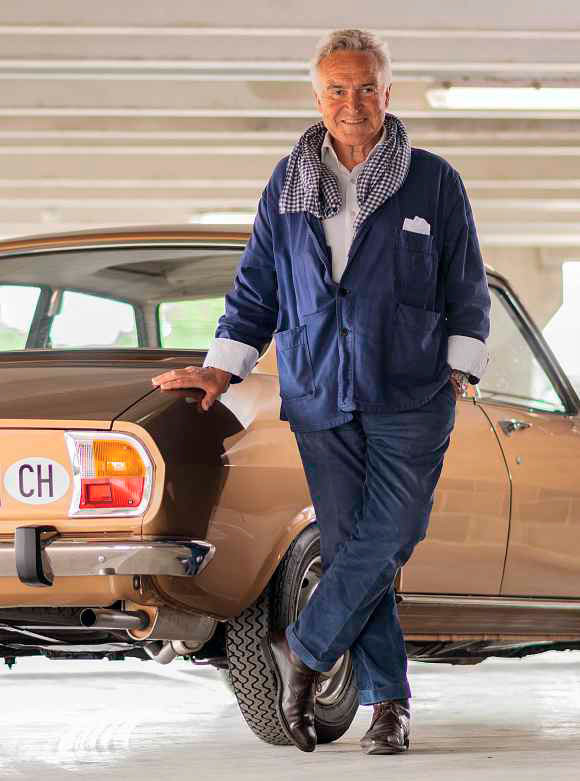
Clockwise from above Structuralist Peugeot is at home in a concrete structure; seat design reflects corduroy favoured by 504’s architect clientéle; engine and dashboard are paeans to the analogue age; Bayley models bleu de travail.


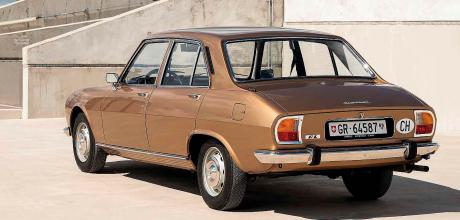
Thanks!
Really true McPherson